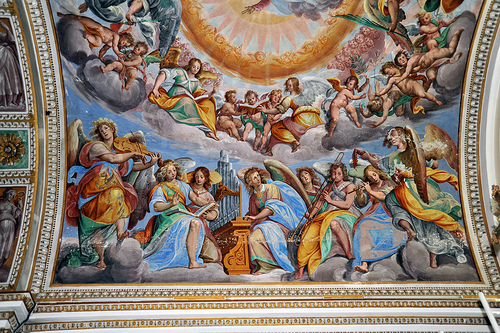Added the below trombone images and entry to the 16th Century (first half) Timeline. This particular trombone image shows characteristics of both a slide trumpet (e.g., the long bell section, the low brace between bell and slide that would preclude movement of a double slide) and a trombone (e.g., a possible double slide, the overall length, the way the instrument is not being gripped near the mouth, and the curve of tubing that extends behind the head). This depiction’s ambiguity places it among other “Curious Images” that may represent the transition between slide trumpet and trombone. As always, the thing to remember, of course, is that artwork is not always literal.

 1608—Gravedona, Italy: Glory of God the Father and the Angels, a fresco by Giovanni Mauro della Rovere (also known as Fiammenghino), located in the Church of Santi Gusmeo e Matteo, includes a depiction of what could be a trombone. The instrument has characteristics of both slide trumpet and trombone; it could simply be an awkwardly-rendered depiction of either instrument. Other nearby angel-musicians play viol, organ, flute, and lute (see facing detail and medium detail below; public domain) (Angelis 43).
1608—Gravedona, Italy: Glory of God the Father and the Angels, a fresco by Giovanni Mauro della Rovere (also known as Fiammenghino), located in the Church of Santi Gusmeo e Matteo, includes a depiction of what could be a trombone. The instrument has characteristics of both slide trumpet and trombone; it could simply be an awkwardly-rendered depiction of either instrument. Other nearby angel-musicians play viol, organ, flute, and lute (see facing detail and medium detail below; public domain) (Angelis 43).